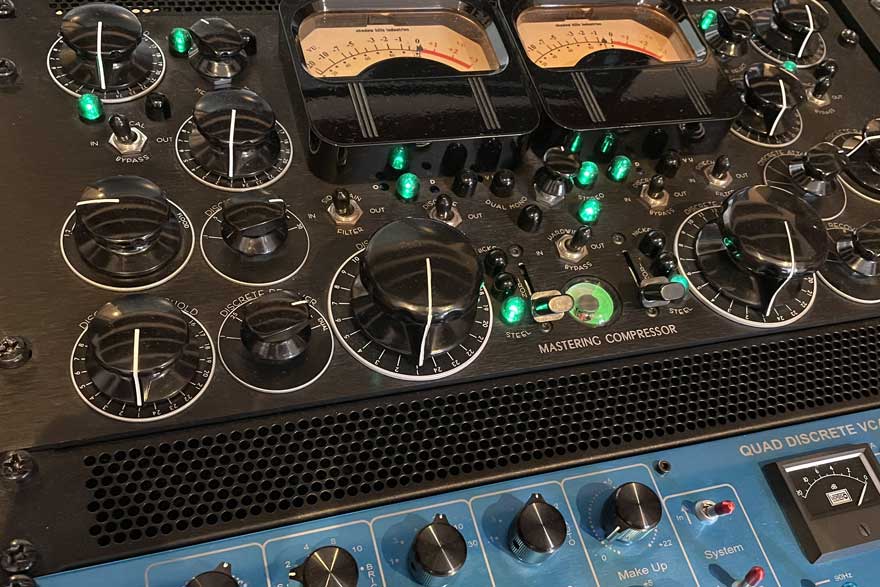Mastering is an under-appreciated part of audio post-production that happens after mixing to achieve a high-quality track.
Have you ever made a track and even though you have the mix right, it’s still not quite as good as your favorite artists?
Maybe nothing specific sounds off but in your heart of hearts, you know that the track isn’t delivering the same excitement as it should. That’s probably because it hasn’t been properly mastered. After mastering, a track sounds out.
Mastering is the last part of preparing recorded audio. After a final mix is prepared, it is given to a mastering professional. As a critical listener, they provide the final touches to the track, balancing out volume, frequencies, EQ, dynamic range compression, and more.
The result of mastering is a loud, dynamic track that lives and breathes like something organic.
What Is The Difference Between Mixing And Mastering?
Mixing is not mastering and mastering is not mixing. When a track is being mixed, recordings are being blended together. Mixing makes sure every clear element in the recording can be heard without conflict with other frequencies.
A mix engineer will deal with individual instruments’ levels, panning, dynamics, and frequency. Then, everything is bounced down in a session to a single track. That track is exported and, from mixing, you might think you have a finished track. But you don’t yet.
Then comes mastering. This is more subtle. It does not affect individual instruments or individual tracks. Mastering happens over a single track – the final mix.
Rather than making significant changes in the instrumentation or mix, mastering focuses on subtle adjustments that the average ear cannot identity but can recognize the excitement from.
To get an amazing-sound track, no matter the genre, a song needs to be properly mixed and then mastered.
As technology has progressed, you will often hear about re-mastered tracks. This is updated mastering that occurs on tracks that were recorded, mixed, and mastered years earlier.
The “Led Zeppelin Remasters” are a fine example of this practice. The music was recorded throughout the 1960s and 1970s, and was then re-mastered for release in the 1990s. No alterations were made to the arrangements or the mix but subtle changes in the updated tracks made the music feel louder, more dynamic, and more exciting.
A Quick History Of Mastering
The history of audio mastering can be traced back to the early days of recorded music.
In the early 20th century, the process of mastering involved physically cutting a master disc from a recording, which was then used to produce multiple copies of a record. This process was done by skilled engineers who had to carefully adjust the levels and EQ of the audio to ensure that the final product was of the highest possible quality.
As technology progressed, the process of mastering evolved.
With the advent of magnetic tape recording in the 1950s, engineers were able to make more precise adjustments to the audio.
The introduction of digital recording and editing in the 1980s and 1990s further revolutionized the process, allowing for even greater precision and control.
Today, mastering is typically done using digital audio software, which allows engineers to make complex adjustments to the audio with ease. Additionally, the digital format and internet distribution have brought a democratization of the mastering process, allowing many individuals to learn and practice mastering on their own.
Why Mastering Is Important
For today’s modern music, audio mastering is the final step in the music production process, and it is essential for several reasons.
First and foremost, mastering ensures that the audio is of the highest possible quality and is consistent across all listening environments.
This includes adjusting the levels and EQ of each track to ensure that they sound balanced and clear on a wide range of speakers and headphones. It also includes processing such as compression and limiting to make sure that the audio is loud and punchy, but not distorted.
Mastering also helps to give the audio a cohesive sound. This is particularly important for albums where the tracks may have been recorded and produced by different people in different locations. Mastering ensures that all the tracks sound like they belong together, and that there are no sudden changes in volume or EQ between tracks.
In addition, mastering can help to make the audio stand out in a crowded market. With so much music being produced and released, it can be difficult for an artist’s work to stand out. A good mastering engineer can help to give the audio a polished, professional sound that will make it more likely to be noticed by listeners and industry professionals.
Mastering Is The Only Way For Your Tracks To Compete With The Biggest Names In Music
Mastering helps to prepare your music for distribution and replication. This includes ensuring that the audio meets industry standards for loudness and dynamic range, and that it is properly formatted for different platforms such as streaming services and physical media.
Mastering is important because it is a critical step in the creative process. The mastering engineer is responsible for taking the raw audio and giving it the final polish and shine that it needs to be ready for release.
This includes making artistic and creative decisions, such as choosing the right EQ settings, adding effects, and adjusting the overall balance of the mix.
In short, mastering is important because it ensures that the audio is of the highest possible quality, consistent across all listening environments, cohesive, stands out in a crowded market, prepared for distribution and replication and it is a critical step in the creative process.
If you are an artist who writes and records music, ensure that you prioritize mastering services before releasing your track to the public.
Mastering is the final polish.









